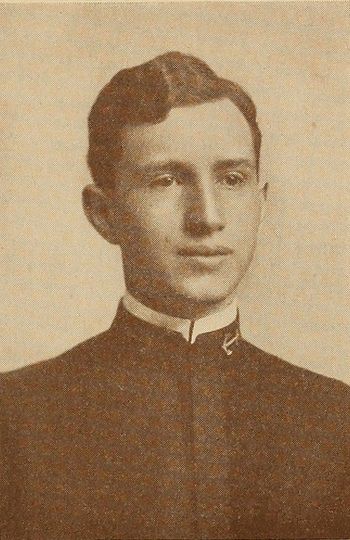JAMES M. MURRAY, LTJG, USN
James Murray '07
Lucky Bag
From the 1907 Lucky Bag:
JAMES McCLEES MURRAY
Thomas, Pennsylvania
"Jimmy"
A happy-go-lucky son of Pennsylvania. Always in an amiable frame of mind and when he smiles he is the envy of all tooth powder advertisers. Is willing to accommodate anyone at anytime even to the extent of lending his melodious voice at a jubilation and can fake anything. Can go to recitation and fill his board with hot air and reel it off until the instructor calls for help. Never in too much of a hurry to catch a smoke. Took his First Class cruise on the hot box Florida, and incidentally played bridge in every part of the ship from dynamo room to fighting top, when he wasn't around collecting fragments of Baldy's outfit.
Class Football (3); Class Track (3); Four Buttons (2); Buzzard (1).

JAMES McCLEES MURRAY
Thomas, Pennsylvania
"Jimmy"
A happy-go-lucky son of Pennsylvania. Always in an amiable frame of mind and when he smiles he is the envy of all tooth powder advertisers. Is willing to accommodate anyone at anytime even to the extent of lending his melodious voice at a jubilation and can fake anything. Can go to recitation and fill his board with hot air and reel it off until the instructor calls for help. Never in too much of a hurry to catch a smoke. Took his First Class cruise on the hot box Florida, and incidentally played bridge in every part of the ship from dynamo room to fighting top, when he wasn't around collecting fragments of Baldy's outfit.
Class Football (3); Class Track (3); Four Buttons (2); Buzzard (1).
Loss
James was lost on February 16, 1914 when the seaplane he was piloting crashed near Pensacola, Florida.
Other Information
From researcher Kathy Franz:
Ensign Walter Douglas Lamont ('10) related the story of the crash in the February 14 issue of The Daily Notes, a Canonsburg newspaper. He said that James had made a short flight earlier in the day, and “later in the day started on a more extended trip over the bay. He had attained a height of about 800 feet and was coming down when the accident occurred. Three dips of about 200 feet each had brought him within 200 feet of the waters of the bay, but when he made the fourth dip the machine failed to work properly, and shot down into the water.
"When the aeroplane struck the water the bow of the machine was caved in, catching Lieutenant Murray and entangling him in the wreckage. He wore a life belt, which would have brought him promptly to the surface had he not become entangled in the wreckage of the machine. Naval officers with glasses watched the flight from an aviation tower, and they saw nothing wrong with the machine until Lieutenant Murray made his fourth dip.
"Rescue boats were on the scene of the accident four minutes after the aeroplane struck the water, and the body was soon released from the wrecked machine. The only mark on the body was a lump on the forehead.”
James was appointed to the Naval Academy by Congressman Acheson.
His father was the pastor of Mt. Prospect United Presbyterian church.
He is buried in Pennsylvania.
Remembrances
From the Naval Aviation Museum, formerly at http://www.navalaviationmuseum.org/history-up-close/nas-pensacola-100th/tragic-loss/:
Long before a British monarch abdicated his throne to marry her and she became the Duchess of Windsor, Wallace Warfield Spencer lived in Pensacola, the wife of a naval aviator. One of her memories of that time was the sound of the bell that would toll when one of the training planes at the naval aeronautic station in Pensacola had crashed. “Whatever else we might be doing on our own account, our subconscious was always waiting for it to sound. Then, once it had sounded, the first frightening thought was ‘Has it sounded for me?’”
Unfortunately, accidents were a frequent occurrence in the early days at Pensacola given the fact that the science of aviation was in its infancy, airplanes were primitive in design, and the pilots learned to a certain extent by trial and error. The U.S. Navy’s first fatality occurred when Ensign William D. Billingsley crashed into the Chesapeake Bay on June 20, 1913, while flying from the aviation encampment at Greenbury Point, Maryland. After naval aviation operations shifted from that site to Pensacola, it was only a short time before Lieutenant (junior grade) James M. Murray lost his life in an aircraft crash, the first aviation fatality to occur at what became known as the “Cradle of Naval Aviation.”
A member of the U.S. Naval Academy’s Class of 1907, where the amiable midshipman’s smile was “the envy of all tooth powder advertisers” in the words of his classmates, Murray spent his first years following graduation at sea on armored cruisers. Like other pioneer aviators he was drawn to submarine duty before turning to flying, commanding one of the earliest boats to operate in the Navy, the A-2 (later named Adder), in the Asiatic Fleet.
Murray reported to Greenbury Point for flight training on July 30, 1913, and was among the complement of aviation personnel who boarded the battleship Mississippi (BB 23) in January 1914, and set course for Pensacola to establish the Navy’s first aeronautic station. On the afternoon of February 16, 1914, Murray took the controls of the D-1 flying boat and ascended from the waters of Pensacola Bay for a training flight. A short time later, Murray’s Naval Academy classmate, Lieutenant (junior grade) Patrick N.L. Bellinger taxied to shore following a flight of his own and heard yelling from shore asking if he had seen Murray’s airplane. Told where he was supposed to have been operating, Bellinger immediately took off and reached an altitude of about 100 feet heading towards Pensacola when he spotted the wreckage of the D-1 in the bay. Alighting on the water nearby, Bellinger spotted Murray floating on the surface and quickly maneuvered his airplane to a point where he could pull his fellow officer aboard. It was too late. Lieutenant (junior grade) James M. Murray, age 30, had drowned. “His death affected me very deeply,” Bellinger later wrote. “It also greatly affected our whole outfit. His was the first death at Pensacola and we had only been flying there two weeks.”
Out of respect for their comrade, no aircraft flew from Pensacola for the next two days, but then operations began again in earnest, with Bellinger destined to fly in combat, establish an altitude record, and perform successful catapult tests in the coming months. When the Navy adopted the designation “naval aviator,” Murray would posthumously be designated Naval Aviator Number 10. Bellinger was number 8, the danger of his professional calling evident in the fact that of the first ten naval aviators, half perished in aircraft accidents.
The "Register of Commissioned and Warrant Officers of the United States Navy and Marine Corps" was published annually from 1815 through at least the 1970s; it provided rank, command or station, and occasionally billet until the beginning of World War II when command/station was no longer included. Scanned copies were reviewed and data entered from the mid-1840s through 1922, when more-frequent Navy Directories were available.
The Navy Directory was a publication that provided information on the command, billet, and rank of every active and retired naval officer. Single editions have been found online from January 1915 and March 1918, and then from three to six editions per year from 1923 through 1940; the final edition is from April 1941.
The entries in both series of documents are sometimes cryptic and confusing. They are often inconsistent, even within an edition, with the name of commands; this is especially true for aviation squadrons in the 1920s and early 1930s.
Alumni listed at the same command may or may not have had significant interactions; they could have shared a stateroom or workspace, stood many hours of watch together… or, especially at the larger commands, they might not have known each other at all. The information provides the opportunity to draw connections that are otherwise invisible, though, and gives a fuller view of the professional experiences of these alumni in Memorial Hall.
January 1908
January 1910
January 1911
January 1912
January 1913
January 1914

The "category" links below lead to lists of related Honorees; use them to explore further the service and sacrifice of alumni in Memorial Hall.